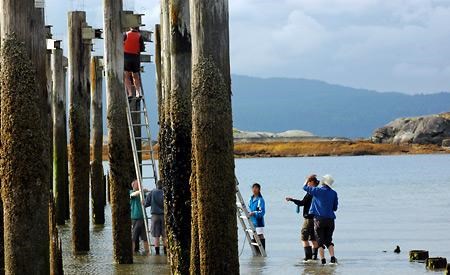Powell River residents probably wondered what all the fuss was about when they were down at Myrtle Rocks this summer. The noisy birds they heard and saw flitting and diving around the nest boxes on the tall pilings were Purple Martins, a Species At Risk in BC and the largest swallow in North America.
These martins were almost extinct in the province when their numbers reached a low of about five pairs in the mid-1980s due to nesting habitat loss. Purple Martins used to nest in abandoned woodpecker cavities in old trees and snags in open, treed areas or bordering fresh water. However, much of their natural nesting habitat no longer exists due to logging, land clearing and urban development.
A nest box recovery program was started in 1986 and nest boxes were installed on old pilings in bays and estuaries around the Strait of Georgia, said Charlene Lee, co-project coordinator of the Georgia Basin Ecological Assessment and Restoration Society’s BC Purple Martin Stewardship and Recovery Program. “Now, due to the efforts of many dedicated individuals participating in the recovery program and helping to maintain and monitor nest boxes at 90 sites, this beautiful swallow will continue to breed in the Georgia Basin area,” Lee said.
In 2011, there were 51 active sites. Myrtle Rocks is one of these active nest box sites, established to provide a home for Purple Martins toward the northern edge of its range. Members and friends of the Malaspina Naturalists Club currently monitor and maintain this site. The first nest boxes were installed at this location in 1998 but it wasn’t until 2002 that Purple Martins started nesting here. By 2005, martins became well established at Myrtle Rocks when 15 pairs successfully raised 58 young. Despite the wind and cool weather at this exposed site, Purple Martins keep returning each year to nest in the boxes at Myrtle Rocks.
“This summer a total of 22 pairs nested here, the highest number yet to call this site home,” said Lee. “Even though the weather has been continually cool and wet, and their insect food was likely not plentiful, they successfully raised 55 young.”
Purple Martins are now heard more often during the summer flying high above parts of Powell River and adjacent areas. They are feeding on large insects and are catching moths, flying ants, beetles and dragonflies to feed their young. Purple Martins were also seen for the first time this summer around pilings in the Lund area, but it is not known if they nested there or were just checking out the location.
The BC Purple Martin population as a whole has increased to an all time high of 735 breeding pairs this year after an exceptionally high production last year. Purple Martins have done well at most colony sites around the Strait of Georgia this year and another population increase is expected in 2012.
Since 2005, a recovery program team from Nanaimo has travelled to Powell River in July or August to put leg bands on the Purple Martin nestlings. Like a birth certificate, the leg bands indicate where the bird was born and how old it is each year it returns. Because the numbers and letters on the colour bands can be read with a spotting scope, this is a non-invasive way to keep track of the birds in the BC Purple Martin population.
Each spring biologists and naturalists read the numbers on the martin leg bands at a number of sites around the Strait of Georgia. Martins banded at Powell River have been found nesting at the following colony sites between 2005 and 2010: on Vancouver Island at Campbell River, Oyster Bay, Comox, Royston, Buckley Bay, Fanny Bay, Nanoose Bay, and Cowichan Bay and in the Lower Mainland at Iona Island. Similarly, the birds nesting at Myrtle Rocks likely originate from many other colonies around the Strait of Georgia and possibly from a few colonies in Puget Sound. This dispersal between colony sites results in a strong genetic mixing in the BC Purple Martin population.
By early September, Purple Martins have begun their migration to southeast South America where they spend the winter. The estimated round trip from North America to South America and back is 20,000 kilometres. The oldest martins found in BC to date have been 11 years old. “Imagine making this trip to South America and back 11 times,” said Lee. “That is quite a journey for a bird about the size of a robin.”
Lee said Powell River residents should keep an eye and ear out for Purple Martins returning to their home at Myrtle Rocks next spring in April and May.
More information about the BC Purple Martin Stewardship and Recovery Program is available on its website and at www.saveourmartins.org.



